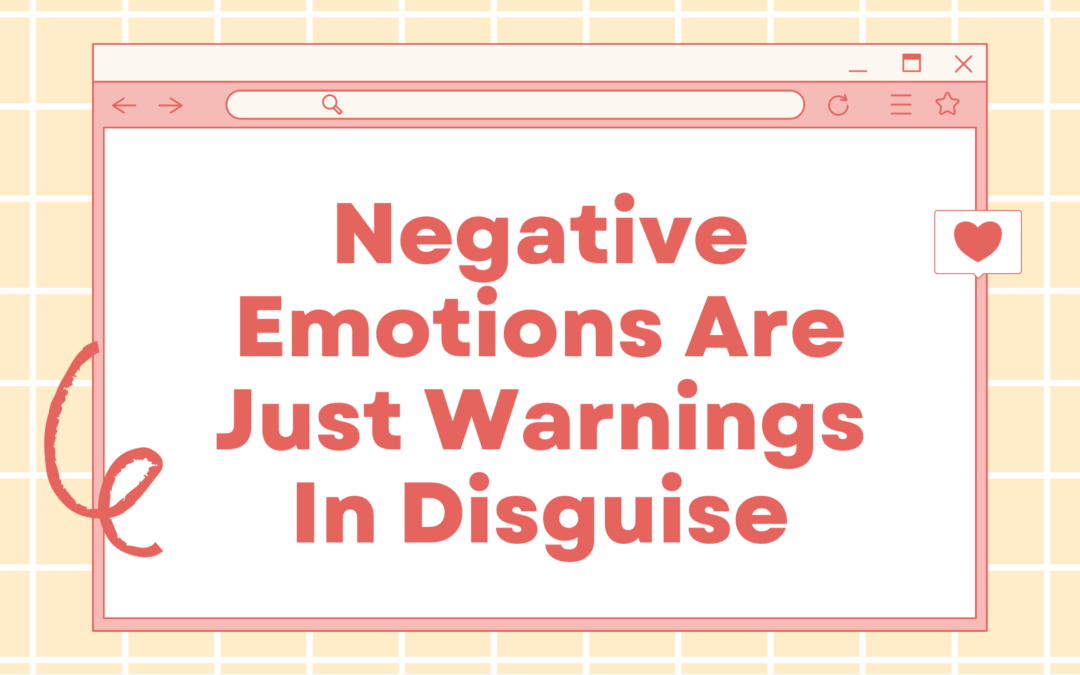How has your week been?
Even though this week was just as long as any other week – 7 days – it felt longer for me. More mentally exhausting and challenging.
But there were bright sides here too. And one of them was an instagram post I came across (I didn’t save it and now I can’t find it anymore :/ ).
It talked about how negative emotions aren’t all that negative. They’re actually just call to action. Like a warning that something is wrong and it needs to be fixed.
Just saying that negative emotions are warnings sounds a little vague, don’t you think? A warning for what?
To understand that let us first understand the main categories of negative emotions:
- Uncomfortable – Impatient, uneasy, distressed, mildly embarrassed.
- Fear – Concern, apprehension, scared, terrified.
- Hurt – Sense of loss.
- Anger – mildly irritated, resentful, livid, rage.
- Frustration – held back or hindered in the pursuit of something.
- Disappointment – sad, defeated.
- Guilt – emotions or regret.
- Inadequacy – less than or unworthy.
- Overloaded – overwhelmed, hopeless, or depressed.
- Loneliness – apart or separate from.
Now let us understand how these emotions translate into action signals, and what they actually tell us. Our aim is to either change our actions, or our perspective because things aren’t working out too well.
- Uncomfortable – When things don’t feel right, it’s a sign that something needs to be done. Pause and think about what you really want, then take steps towards making it happen.
- Fear – Fear is like a warning bell, telling you to get ready. It’s your cue to brace yourself and prepare for the unknown. If circumstances are out of your control, then it might be best just to accept them and let go of any negative feelings associated with fear. There’s no point in holding onto something that harms you.
- Hurt – Hurt can be a sign that you’re expecting something to happen, but it isn’t. Before reacting too quickly, try evaluating if there really is a loss and consider how your perception or communication of needs might need adjusting- sometimes changing these things can lead to different outcomes.
- Anger – Anger can often be a sign that somebody has crossed an important boundary or violated your personal values. It is essential to gain clarity on our rules and expectations, so we don’t have unrealistic expectations of ourselves and others which result in constant frustration and anger. Acknowledging the difference between different peoples’ sets of standards may also help us avoid feeling resentful throughout life.
- Frustration – If you’re feeling stuck in the same cycle, take a step back and reassess. Rather than getting more of the same results by continuing with your current approach, shake things up and try something new to reach your target.
- Disappointment – Life is constantly throwing curveballs, and this could be a sign that the end result you had been hoping for might not come to fruition. Take some time to step back and reassess your expectations; have you miscalculated somewhere along the way? Perhaps setting more reasonable goals in terms of timeline would help prevent disappointment down the line.
- Guilt – Feelings of guilt arise when we recognize that something isn’t up to par with our own standards. But rather than becoming consumed by this emotion, it’s important to acknowledge and address the root cause in order to move forward. When a mistake can’t be reversed, practice self-compassion; reframe your perception and commit yourself towards better actions going forwards instead – creating healthier habits for both present & future growth.
- Inadequacy – It’s time for a change. Challenge yourself to take proactive steps towards improvement, such as practice. Remember that it is not about being perfect – simply put in the effort and let your results speak for themselves. The only way out of feeling of inadequacy is to take action.
- Overloaded – It’s time to reflect on what matters most right now, and figure out where your needs end and wants begin. Make a list of all of these details – start with the top priority one – then focus in on taking action. Every small step helps you take back control from events that may be beyond your grasp & simplifying it makes any task more achievable.
- Loneliness – Loneliness can often be a sign that we crave companionship. Taking the time to identify what kind of connection you’re looking for – whether it’s somebody with whom you can just have fun, someone who listens to your stories or something else entirely – and then learning how best to go about finding those meaningful relationships is key in creating lasting bonds.
Still haven’t subscribed to my newsletter? Subscribe here to get the blog post in your inbox every Sunday. I’m also gonna talk about stuff randomly there, so make sure you don’t miss out 🙂

